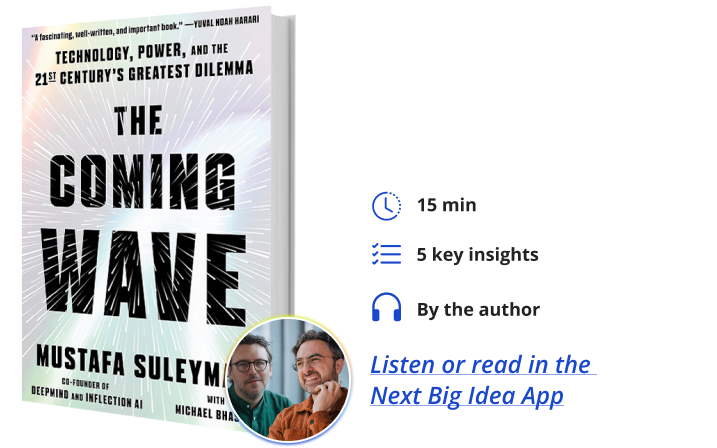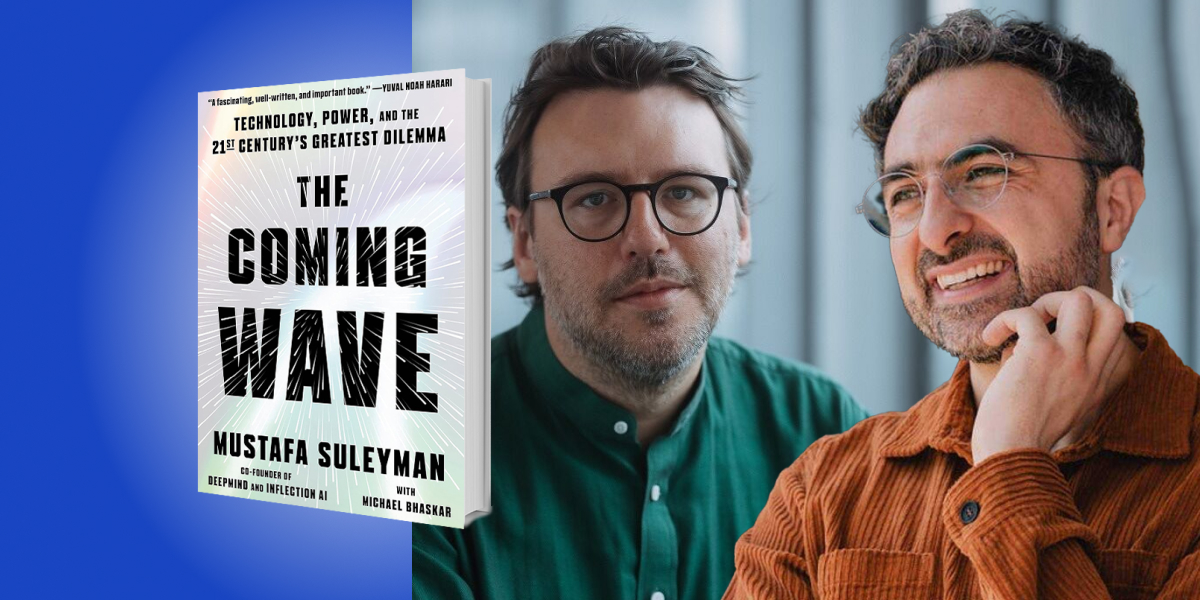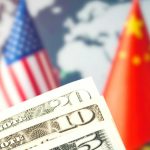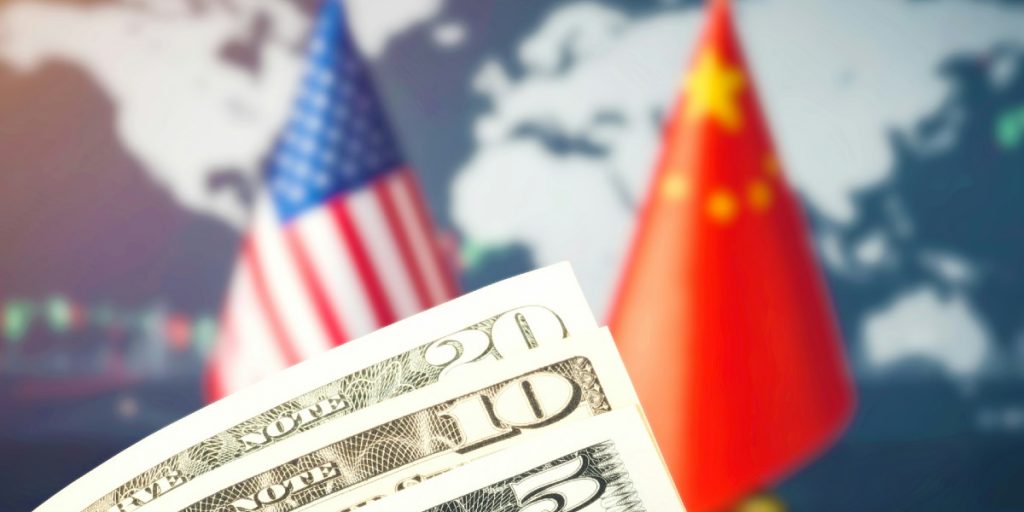Michael Bhaskar is a writer, publisher, researcher, and entrepreneur. He is Co-Founder of Canelo, a new kind of publishing company and Europe’s fastest-growing independent publisher. Between 2017 and 2019 he was a consultant Writer in Residence at DeepMind, the world’s leading AI research lab. His writing has been featured in and written for The Guardian, Wired, the BBC World Service, and NPR, amongst others.
Mustafa Suleyman is the co-founder and CEO of Inflection AI. Previously he co-founded DeepMind, one of the world’s leading artificial intelligence companies. After a decade at DeepMind, Suleyman became vice president of AI product management and AI policy at Google.
Below, co-authors Michael and Mustafa share 5 key insights from their new book, The Coming Wave: Technology, Power, and the Twenty-first Century’s Greatest Dilemma. Listen to the audio version—read Michael—in the Next Big Idea App.

1. Humanity has been shaped by successive waves of technology.
Over millennia, humanity has been shaped by successive waves of technology. The discovery of fire, the invention of the wheel, and the harnessing of electricity were all transformational moments for civilization. All were waves of technology that started small with a few precarious experiments but eventually broke across the world. These waves also will follow a similar trajectory. Breakthrough technologies were invented, delivered huge value and then proliferated, becoming more effective, cheaper, and more widespread. They were eventually absorbed into the normal, ever-evolving fabric of human life. Proliferation like this is the default, and going forward, there are compelling reasons to believe that will be true again. We are about to cross a critical threshold in the history of our species. This coming wave of technology is poised to be the most transformational in human history.
Built around the general-purpose technologies of AI and synthetic biology, this wave is one of nothing less than intelligence and life. In just a few years, for example, AI models have gone from hundreds of millions to trillions of parameters, a core measure of a system’s complexity and size. Chap GPT and GPT4 took the world by storm as the fastest proliferating consumer technologies in history. AI is moving forward more quickly than even industry experts can track. And now this exponential change is expanding to biotech, robotics, quantum computing, and new energy sources. The cost of sequencing DNA, for example, has collapsed. We also have a growing ability to synthesize it, write the code of life, and create new organic forms. So understanding and reckoning with this wave is absolutely vital for us all.
2. We need better categories for understanding new eras of technology.
Over recent months, as AI has exploded in the public consciousness, most of the debate has been sucked towards one of two poles. On the one hand, there’s the basic machine learning, AI as it already exists on your phone, in your car, and in ChatGPT. On the other hand, there’s still speculative artificial general intelligence, AGI, or even super intelligence of some kind—a putative and uncertain existential threat to humanity due to arrive at some hazy point in the future. These two, AI and AGI. utterly dominate the discussion. But making sense of AI means we urgently need something in between, something coming in a near to medium timeframe whose abilities have an immense tangible impact on the world.
“These are AIs that don’t just say things like chat bots; they do things.”
This is what artificial capable intelligence (ACI) does; it describes what is coming in the next two to five years. These ACIs will achieve a wide range of predetermined goals on their own. These are AIs that don’t just say things like chat bots; they do things. They accomplish goals autonomously. These AIs will organize a retirement party and manage your diary, but by the same token, they will develop and execute business strategies whilst designing new drugs to fight cancer or dominate entire sectors. They will plan and run hospitals or invasions just as much as they will answer your email.
Focusing on either of these others, AI or AGI or missing ACI, is as myopic as it is dangerous. Therefore, we have proposed a modern Turing test that will act as a warning that we’re in a new phase for AI. In the test, if an AI can go make a million dollars on the internet on its own, it is an ACI. We need better categories for understanding a new era of technology, the era of ACI. In this era, little will remain unchanged. We should start preparing for this now.
3. The wave will transform the nature of power.
Power is the ability to accomplish goals everywhere. Now it’s going to be in the hands of anyone who wants it, and that’s going to be most people. This wave is far more empowering than the web ever was. This is what ACI and the associated technology like robotics, quantum computers, and synthetic virology will bring.
The reason it transforms power is that everyone gets access. Think of it like this: in previous eras most powerful technologies were generally reserved for a small capital-rich elite or national governments. Building a steam-powered factory, an aircraft carrier, or a nuclear power plant was a costly, difficult, and immense endeavor. With the leading technologies of our time, that’s no longer going to be true. If the last great tech wave—computers and the internet—was about broadcasting information, this new wave is all about doing.
We are facing a step change in what is possible for individual people to do and facing it at a previously unthinkable pace. AI is becoming more powerful and radically cheaper by the month. What was computationally impossible and would cost tens of millions of dollars a few years ago is now widespread. This means that it’s a very powerful extension of our best and our worst selves, and it’s everywhere. Whether it’s commercial, religious, cultural, military, democratic, or authoritarian, every possible motivation you can think of can be dramatically enhanced by having cheaper power at your fingertips. These tools will be available to everyone, billionaires and street hustlers, kids in India and pensioners in Beverly Hills. It’s a proliferation of not just technology but capability—power itself.
4. The dilemma: technology’s political consequences are too often ignored.
There are bold and concerning arguments that these technologies fatally imperil the nation-state. It’s no secret that technologies like AI could give bad actors a new toolkit, spur on a surge of misinformation, and take away jobs. While they will deliver immense benefits, they will also amplify societal fragility. They could even present an existential threat to the nation-state, introducing risks so profound, they may disrupt, or even overturn the current political order. At the same time, they open pathways to AI-empowered cyberattacks, automated wars that could devastate countries, or engineered pandemics that put the world at the mercy of unexplainable and yet seemingly omnipotent forces. The likelihood of each may be small, but the possible consequences are huge. Even a slim chance of outcomes like these requires serious attention.
“Can we strike a balance between openness and closure?”
Presented with scenarios like this, people often have a natural pessimism or aversion, as we call it, a tendency to dismiss such assessments as overblown scaremongering. But this is the reality of what’s coming, and faced with it, we’re seemingly left with two unwelcome endpoints. On the one hand, a surveillance state stamps out any risk at the expense of freedoms and progress. On the other, an eventual catastrophe born of runaway development. This is the dilemma at the heart of the 21st century. Can the world find a narrow path between these outcomes? Can we strike a balance between openness and closure? This presents an urgent generational challenge, one on a par with the climate crisis.
5. Containment is the vital and missing concept for our time.
A fire hose of discussion now surrounds technology and its risks, but what’s missing is a central unifying idea. As the conversation around technology has exploded, we are still missing a unified approach to understanding, mitigating and controlling the spiraling new powers—a general-purpose concept for a general-purpose revolution.
We propose containment as the answer. It’s an overarching lock uniting cutting-edge engineering, ethical values, government regulation, and international collaboration. Containment is, in short, the elusive foundation for building the future. To manage the wave, we need a containment program working in 10 concentric layers:
- Built-in technical safety measures, and concrete means to ensure safe outcomes
- Audit mechanisms that ensure technologies’ transparency and accountability
- Use of choke points in the ecosystem to buy time for regulators and defensive technologies
- Responsible committed makers or critics invested in actually making contained technology, not just looking in from the outside
- Reshaped corporate incentives and structures taking us away from a heedless race
- Government regulation to license and monitor the technology
- International treaties up to and including new global institutions
- Cultivating the right culture around technology and grading the precautionary principle in the tech
- Social movements, always a part of widespread change, to agitate
- Finally, all of these measures need to be made to cohere adding up to a comprehensive program.
None of it will be easy, but do so and we can forge that narrow path to a secure and flourishing future. What once would have been centuries or millennia of technological change is now happening in a matter of years or even months. Consequences ricochet around the world in hours or seconds. Containment is the response we need.
To listen to the audio version read by co-author Michael Bhaskar, download the Next Big Idea App today:






























